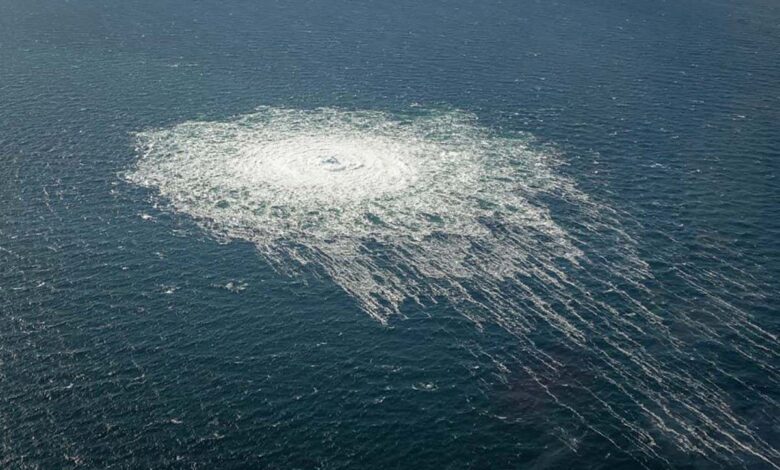Russia’s gas pipelines to Europe, Nord Stream, have strange leaks.

Within hours of one other, critical gas pipelines between Russia and Europe, Nord Stream 1 and Nord Stream 2, sprung huge breaches, triggering worries of purposeful sabotage.
Within hours of each other, two important gas pipelines built to transport Russian gas to Europe sprung leaks, triggering speculation of sabotage. The Nord Stream pipelines, which run beneath the Baltic Sea, have at times been the epicentre of diplomatic problems surrounding the Russian invasion of Ukraine. The leaders of the European Union have already accused Russian President Vladimir Putin of manipulating energy supplies in reaction to severe sanctions from Europe and the United States.
The Danish Energy Agency stated in a press release that two leaks have been detected on Nord Stream 1 – one in Danish territory and one in Swedish territory – and that one leak has also been discovered on Nord Stream 2. The alert level was upgraded to orange, the second-highest level.
The agency’s head, Kristoffer Bottzauw, issued the following statement: “Gas pipeline ruptures are exceedingly rare, and as a result of the accidents that have occurred in the past 24 hours, we believe it is necessary to increase our level of preparedness. We want to establish comprehensive monitoring of Denmark’s vital infrastructure to boost future supply security.”
According to reports, the leaks are huge holes, not little ones.
According to a European security source, there are signs that the breaches were the result of “deliberate damage.” The prime minister of Denmark, Mette Frederiksen, stated, “It is difficult to believe that these are mere coincidences. We cannot exclude sabotage.”
The gas spill at Nord Stream 2 as viewed from a Danish fighter aircraft.
Danish Military Command
Denmark has set a 5-nautical-mile exclusion zone surrounding the leaks, prohibiting all ships and aircraft from approaching. Due to the leaking gas, there is a risk of ignition and ships could lose buoyancy.
The Petroleum Safety Authority Norway issued a statement on Monday indicating that it has lately received multiple alerts from oil and gas businesses regarding suspicious drones and planes flying close to offshore facilities. In addition, the organisation issued a reminder that there is a 500-meter exclusion zone around all offshore oil and gas facilities, and that trespassing on it could be illegal. However, it stated that it would not speculate on the causes of the Nord Stream breaches.
Anthony King of the University of Warwick in the United Kingdom deems the occurrence peculiar and suggests that sabotage and accident are both possible.
“The Russians have the means to carry out such an attack, and they often threaten internet cables in the Atlantic to demonstrate that they could do so if required. So it may be the Russians,” he concludes. “However, I do not understand what they would gain – they want to sell gasoline. It could very well be an accident.”
Monday, at 00:03 UTC and 17:03 UTC, the GFZ German Research Centre for Geosciences reported two strong and distinct increases in seismic activity beneath the Baltic Sea, according to a spokeswoman. This was followed by seismic noise that was “far greater” than typical before the spikes. They state, “We have no information regarding the cause of the spikes and the noise.”
Each of the two impacted pipelines consists of two pipelines made up of about one million 12-metre-long pieces. At the time the leaks were discovered, none of the pipelines were operational, but they all contained pressurised gas. According to the network’s environmental impact studies, the pipes are 26.8 millimetres thick and coated with anti-corrosion material and steel-reinforced concrete.
Although Nord Stream 2 was not yet in normal operation, it was already filled with 177 million cubic metres of natural gas. Scientists disagree on the magnitude of this gas leak’s impact on the environment and climate change.
As the methane rises through the water, it transforms into carbon dioxide, which is a less potent greenhouse gas. According to Joe von Fischer of Colorado State University, the effect of the leaks on atmospheric methane levels would be minimal because the methane will transform into carbon dioxide, which is less potent as a greenhouse gas. “When methane is produced at the bottom of a deep body of water, methanotrophic bacteria in the water column oxidise nearly all of it,” he explains.
However, according to Grant Allen of the University of Manchester in the United Kingdom, the rising amount of gas may alter the situation. “My intuition, and this is really intuition, is that those leaks are so large that a column of bubbles rising to the surface will be so pure and intense that nature won’t have a chance to react,” he says. “It is evident how forcefully it is erupting. I anticipate that this event will conclude in a matter of hours.”
Allen predicts that the contents of the Nord Stream 2 pipeline would produce the same amount of methane emissions as 124,000 typical British homes per year.
Since Russia’s invasion of Ukraine, the pipelines are not the only energy infrastructure to be damaged. In recent months, fighting near the Zaporizhzhia Nuclear Power Plant — the largest nuclear plant in Europe – and Chernobyl has prompted scientists to warn of the possibility of an unintentional leak of radioactive material.




